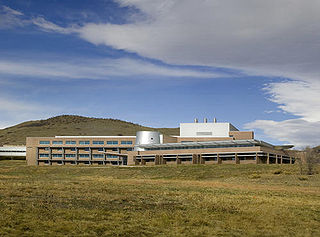Related Research Articles

The United States Department of Energy (DOE) is an executive department of the U.S. federal government that oversees U.S. national energy policy and manages the research and development of nuclear power and nuclear weapons in the United States. The DOE oversees the U.S. nuclear weapons program, nuclear reactor production for the United States Navy, energy-related research, and domestic energy production and energy conservation.
Technology transfer (TT), also called transfer of technology (TOT), is the process of transferring (disseminating) technology from the person or organization that owns or holds it to another person or organization, in an attempt to transform inventions and scientific outcomes into new products and services that benefit society. Technology transfer is closely related to knowledge transfer.
The Agenzia nazionale per le nuove tecnologie, l'energia e lo sviluppo economico sostenibile (ENEA) is an Italian Government-sponsored research and development agency. The agency undertakes research in areas which will help to develop and enhance Italian competitiveness and employment, while protecting the environment. ENEA is an acronym that stands for Energia Nucleare ed Energie Alternative.

The National Renewable Energy Laboratory (NREL) in the US specializes in the research and development of renewable energy, energy efficiency, energy systems integration, and sustainable transportation. NREL is a federally funded research and development center sponsored by the Department of Energy and operated by the Alliance for Sustainable Energy, a joint venture between MRIGlobal and Battelle. Located in Golden, Colorado, NREL is home to the National Center for Photovoltaics, the National Bioenergy Center, and the National Wind Technology Center.

Microelectronics and Computer Technology Corporation, originally the Microelectronics and Computer Consortium and widely seen as the acronym MCC, was the first, and at one time one of the largest, computer industry research and development consortia in the United States. MCC ceased operations in 2000 and was formally dissolved in 2004.
The Institute for Telecommunication Sciences (ITS) performs the research and engineering that enables the U.S. Government, national and international standards organizations, and many aspects of private industry to manage the radio spectrum and ensure that innovative, new technologies are recognized and effective.
The Institute for Defense Analyses (IDA) is an American non-profit corporation that administers three federally funded research and development centers (FFRDCs) – the Systems and Analyses Center (SAC), the Science and Technology Policy Institute (STPI), and the Center for Communications and Computing (C&C) – to assist the United States government in addressing national security issues, particularly those requiring scientific and technical expertise. It is headquartered in Alexandria, Virginia.
The Office of Energy Efficiency and Renewable Energy (EERE) is an office within the United States Department of Energy. Formed from other energy agencies after the 1973 energy crisis, EERE is led by the Assistant Secretary of Energy Efficiency and Renewable Energy, who is appointed by the President of the United States and confirmed by the U.S. Senate. Kelly Speakes-Backman was appointed Acting Assistant Secretary in January 2021.

The U.S. Trade and Development Agency (USTDA) is an independent agency of the United States government, formed in 1992 to advance economic development and U.S. commercial interests in developing and middle income countries.
In the United States, a cooperative research and development agreement is an agreement between a government agency and another government agency, a private company, non-profit, or university to work together on research and development.
Ferroelectric Liquid Crystal Display (FLCD) is a display technology based on the ferroelectric properties of chiral smectic liquid crystals as proposed in 1980 by Clark and Lagerwall. Reportedly discovered in 1975, several companies pursued the development of FLCD technologies, notably Canon and Central Research Laboratories (CRL), along with others including Seiko, Sharp, Mitsubishi and GEC. Canon and CRL pursued different technological approaches with regard to the switching of display cells, these providing the individual pixels or subpixels, and the production of intermediate pixel intensities between full transparency and full opacity, these differing approaches being adopted by other companies seeking to develop FLCD products.
The National Nuclear Security Administration (NNSA) is a United States federal agency responsible for safeguarding national security through the military application of nuclear science. NNSA maintains and enhances the safety, security, and effectiveness of the U.S. nuclear weapons stockpile; works to reduce the global danger from weapons of mass destruction; provides the United States Navy with safe and effective nuclear propulsion; and responds to nuclear and radiological emergencies in the United States and abroad.

The National Center for Preservation Technology and Training (NCPTT) is a research, technology, and training center of the U.S. National Park Service located on the campus of Northwestern State University. Since its founding in 1994, NCPTT has awarded over $7 million in grants for research that fulfills its mission of advancing the use of science and technology in the field of historic preservation. NCPTT undertakes research at its in-house laboratories at Lee H. Nelson Hall in Natchitoches, Louisiana. Working in the fields of archeology, architecture, landscape architecture and materials conservation, the National Center accomplishes its mission through training, education, research, technology transfer and partnerships.
The NIH Office of Technology Transfer (OTT) plays a strategic role by supporting the patenting and licensing efforts of our NIH ICs. OTT protects, monitors, markets and manages the wide range of NIH discoveries, inventions, and other intellectual property as mandated by the Federal Technology Transfer Act and related legislation.

Cherokee Nation Businesses, LLC (CNB) is an American conglomerate holding company headquartered in Catoosa, Oklahoma that oversees and manages several subsidiary companies. CNB is a wholly owned subsidiary of the Cherokee Nation, the largest Native American tribe by population in the United States. CNB operates in the following industries: aerospace and defense, hospitality and entertainment, environmental and construction services, information technology, healthcare, and security and safety.

The Networking and Information Technology Research and Development (NITRD) program consists of a group of U.S. federal agencies to research and develop information technology (IT) capabilities to empower Federal missions; support U.S. science, engineering, and technology leadership; and bolster U.S. economic competitiveness.

The Stevenson–Wydler Technology Innovation Act of 1980 was the first major U.S. technology transfer law. It required federal laboratories to actively participate in and budget for technology transfer activities.
The Office of Research and Technology Applications (ORTA) is an organizational structure established in United States federal laboratories through the Stevenson-Wydler Technology Innovation Act of 1980, specified in 15 USC § 3710. The acronym "ORTA" has evolved to refer to those who perform the functions of the ORTA organization. By law, the ORTA must be staffed by at least one full-time person in any laboratory with 200 or more scientific, engineering, or related technical positions, in order to coordinate and promote technology transfer.

The United States Federal Technology Transfer Act of 1986 was, after the Stevenson-Wydler Technology Innovation Act of 1980, the second major piece of legislation focused on technology transfer from federal government agencies to the commercial sector. The act established the Federal Laboratory Consortium and enabled federal laboratories to enter into Cooperative Research and Development Agreements (CRADAs) and to negotiate licenses for patented inventions made at the laboratory.
The Electronics Technology and Devices Laboratory (ETDL) was a research institution located at Fort Monmouth, New Jersey that served as the U.S. Army's central laboratory for electronics research from 1971 to 1992. ETDL was one of the seven Army laboratories that merged to form the U.S. Army Research Laboratory (ARL).
References
- ↑ http://thomas.loc.gov/cgi-bin/bdquery/D?d099:32:./temp/~bdADeP:@@@L&summ2=m&%7C/bss/99search.html%7C%5B%5D
- ↑ Archived May 15, 2008, at the Wayback Machine
- ↑ "About the FLC". Federallabs.org. Retrieved 2013-04-07.